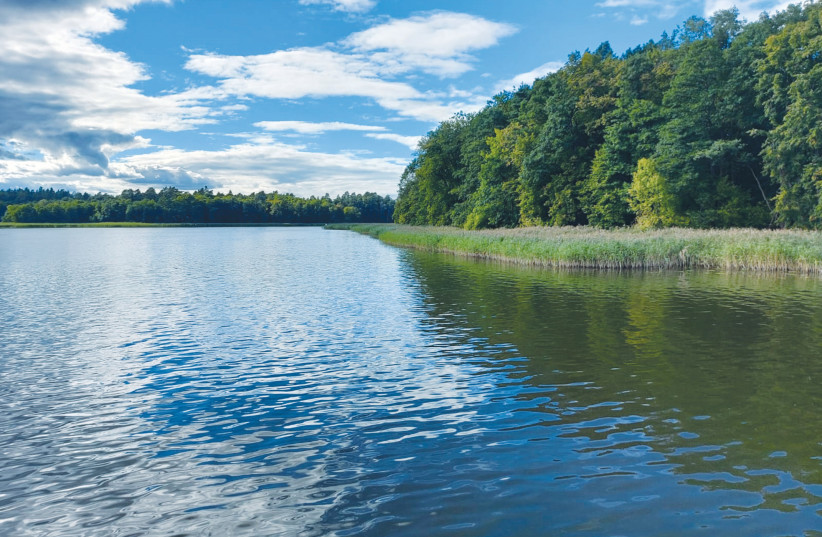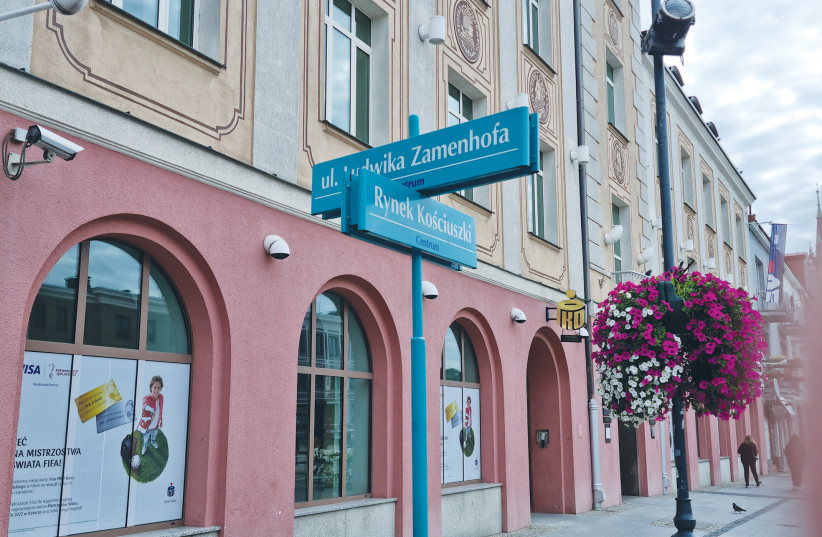Where other airports usually greet incoming tourists with a “welcome” sign, Warsaw’s Chopin Airport greets them with a forthright declaration: “We Are Proud to Be Polish.” Maybe the sign is meant for returning Poles from the diaspora, but it would equally explain why Poland’s Tourism Organization invited a group of Israeli travel writers for a week’s tour of the country’s hidden beauty spots.
To that end we were whisked directly from the airport to the country’s far northeast, a five-hour drive to a land of forests and lakes along well kept tarmac roads that slice through mile after mile of sun-dappled forests of golden pine and silver birch trees, to a region that is home to the oldest primeval forest in Europe, much of it close to the tightly guarded border with Belarus, on the other side of which, lies four-fifths of the forest and the new frontier between Eastern and Western Europe, of which Poland is now an integral member.
In the 13th century, it is said one could walk from Poland to France without seeing the sun for all the trees and foliage. Much of that forest has been cut down, and the superb weather we enjoyed meant there was no shortage of exposure to sunlight.
Our first stop was Augustow, in the Suwalki region, popular among Poles, and also Germans and Belarusians, for its scenery, water sports, spas and fine accommodation. The summer was coming to an end, so it was less busy than in the month of its namesake. The Augustow forest is the biggest in Poland, but where one forest ends and another begins may be more a matter of administrative decision than geography since 30% of the country is still forested,much of it re-forested a century ago.
Today, rivers and their tributaries carved out by melting glaciers, only 12,000 years ago, have created nine lakes, like azure beads on a multiple-strand necklace, which set against the pristine forests, recent or older, dominate the otherwise flat landscape like a bushy green mane on the crown of Poland. Deposits of therapeutic mud and essential oils secreted by the trees of the forest make this area a center of herbal medicine.

Where we stayed
The hotel we stayed in, the Warsawa, was no doubt intended to attract the capital’s more well-to-do denizens. Cruising on Lake Necca outside the hotel’s backdoor, gliding kilometers in kayaks down sodden wood-banked streams gilded with water lilies, and fallen tree trunks adorned in a mantle of sparkling moss, only the border with Belarus would prevent an intrepid kayaker taking the River Rospoda to its end. Dark-haired Agnieska, who runs the local kayaking club, who showed us the ropes, or rather the oars, breaks into an infectious smile as she compares the jungle-like river system to a shorter Amazon without alligators.
Insects were considered the only hazard, yet, though the region teems with wildlife, and we were even equipped with mosquito repellent, none was needed.
For those allergic to primitive waterways and mosquitoes, a 2,000-km. cycle path running parallel to the unseen Belarus border reminds you that you are on the frontline of Europe. An occasional Ukrainian flag appears.
FROM AUGUSTOW we drove south to Bialystok, the largest town in the area, (Augustow is second), where our guides introduced us to whom they considered one of its most famous denizens of the last two centuries, Ludwik Zamenhof, the utopian inventor of Esperanto who believed that if he could get the world to speak his simplified and artificial language he could dissipate much of the hostility among different language speakers that marred human existence.
He died in 1917 during World War I, never to see the worst fulfillment of his fears, but is father to an estimated two million Esperanto speakers. Zamenhof’s practical utopianism resonates with the romantic nature of the Polish character. Not only streets, as in Israel, but a statue of the young Zamenhof graces a street named for him that opens into the central square, named for Poland’s foremost national hero, the military leader, Tadeusz Kosciusko.
A true son of the enlightenment who fought for Poland’s freedom, and lost, Kosciusko in exile became a hero of revolutionary France, and in the early United States campaigned against slavery before Lincoln was even born.

Bialystok boasts the Basilica of the Assumption of the Blessed Virgin Mary, 90 meters long with accommodation for almost 10,000 worshipers. Judging from the turnout on Saturday afternoon, when it was half full with young as well as old people, Sunday Mass – of which there are three during the day – must be a sell-out, an indication of the Roman Catholic Church’s influence in Poland, three decades after the end of Communism, hastened in Poland under the influence of Solidarity and Pope John Paul II.
Religious faith is supplemented by the Orthodox, who make up, I was told, more than one-fifth of Bialystok’s population, considerably more than the Orthodox Church’s representation in Poland as a whole. The Orthodox are mostly from areas, like Bialystok, that were long under Russian tsarist rule. But make no mistake, I was told. The Polish Orthodox Church is no less proudly Polish than the Catholic Church.
In Bialystok, as in Warsaw, many historic bombed buildings were rebuilt exactly to their original state, and so a city “owned” by a single aristocratic family in the 18th century, the Branickis, dominates the townscape with their yellow and white facades, as though the last war had never touched them.

FROM THERE we traveled to Podlaski Ogrod Ziolowy, the Podlasie Herb Garden, where we were invited to absorb the aroma of the dozens of different shrubs in a herbarium that might have been a medieval apothecary.
The different herbs were said to cure a variety of physical, psychological and mental ailments, and became very drinkable when shaken together in a bottle half-filled with local Zubr (Bison) vodka.
The proprietor of the garden, a handsome stocky man with grizzled features and a bulbous nose, told us that he learned much about herbal medicine from a book titled Lecznictwo Lubo Polskiego, which he called “my Bible.”
Its author, Henryk Biegeleisen, a Polish Jew, (1855-1934), born in a small Galician town, now in Ukraine, that was 40% Jewish in his time, became a preeminent specialist in 18th-19th century Polish literature. Late in life he delved more deeply still into Polish culture, publishing studies of Polish customs, beliefs and folk traditions. His book on Polish folk medicine, written during that period, remains untranslated. In English it might be called “The Polish Way to Harmonious Treatment of Ailments.”
Wending our way back down to Warsaw, we stopped off briefly in Biaolwieza Towarowa, literally a stone’s throw from the Belarus border. Bialoweiza flaunts its Russian past. It was a favorite vacation spot of Tsar Nicholas II, who built a summer palace here, which did not survive the war. To get here Nicholas built a railway through the Bialoweiza Forest, almost as large as the Augustow Forest at 150,000 hectares. Nearby in this “green lung” of the country, is a breeding ground for the European bison; a few of the 700 extant in Poland we saw earlier on a reserve in a cleared part of the forest between Augustow and Bialoweiza.

To this day the tsar’s private train remains parked outside the old station, now a hotel-restaurant, the only tsar-constructed building the Germans left standing there after World War II. The two carriages of the Imperial Railway have been converted into bedroom suites. Next to it a carriage, purchased from Communist East Germany in the sixties has been converted into a restaurant car, which, powered by the tsar’s steam locomotive or a smaller engine, takes diners on an 8-km. trip along the railway track. A waiter told me it served as a mobile Nazi telegraphic communications center in the fuehrer train during the invasion of Poland.
Our group dined under a large portrait of the last tsar; I on Polish borscht, a thicker beetroot soup than the Ukrainian original, and cheese and potato pierogi, which were the best I had in Poland, downed with a fine local white wine.
The prominent portrait of the tsar in Bialoweiza could be attributed to his historic association with the place, but a similar portrait reappeared in Kiermusy, our last stop before returning to Warsaw, a rural community carved out of the forest, with more rustic and atmospheric accommodation than we had hitherto experienced. There, in Dworek Nad Lakami, along with portraits of the ill-starred tsar and his family, an even larger portrait of Rasputin, the mad monk, graced the dining hall.
And back to Warsaw. The Fryderyk Chopin monument in the beautiful park named for him is a sweepingly romantic caped rendition in bronze of the great Romantic composer and Poland’s proudest son. Inevitably the Nazis destroyed the monument and banned his music for fear his mazurkas would stir Polish patriotism.
The statue was recast in 1958, like much of old Warsaw.
As for the Warsaw Ghetto, a running ribbon of dark stone around its borders, the new Polin museum of Jewish Polish history (closed Tuesdays when we arrived there), the monument to the fighters of the Warsaw Ghetto, and several plaques, bear mute testament to what once filled the space within.
You Say ‘spaceba’
I say ‘dziekuje’
Preparing for this trip I immersed myself in a couple of weeks of Russian language learning. Why Russian? Because I already understood a few words of the language, having picked up my first word (apart from nyet and nazdarovie) in Kaliningrad in 2015. It was oguretz (cucumber) and I never forgot it.
Since even a journey of a thousand words starts with one, I set off, propelled by the tail-wind of the pending Polish trip. After all, Polish, I was told, was 70% Russian and anyone over 70 spoke it. The few Poles I met said that was an overstatement, but pidgin Russian was still useful and acceptable. But truth be told, only Slovakian is readily comprehensible to younger non-Russian Polish speakers, and they say, that it is a coarser version of pure Polish. So that leads me to say to our gallant hosts “Dziekuje bardzo” for a remarkable tour.
The writer was a guest of the Polish Tourism Organization.
